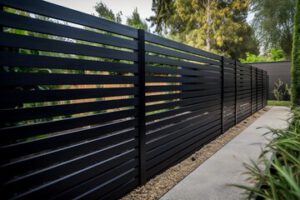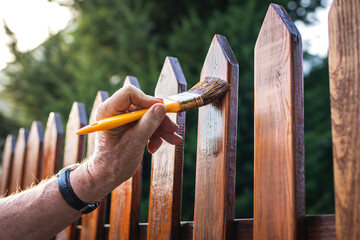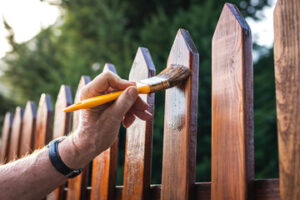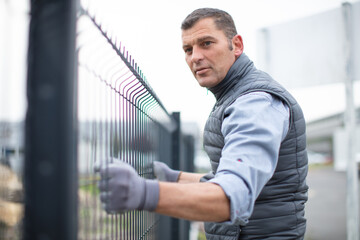Fences improve a home’s aesthetic, offer security for children and pets, and mark property boundaries. They are available in many styles and materials. It’s a good idea to talk with your neighbors and make sure they are on board with your plans before starting construction. It is also a good idea to check with your local government for requirements such as permits.
The cost of fence installation varies by the material and style. However, labor tends to be the larger component of the overall cost. It is helpful to consider the labor costs when calculating your budget, as they tend to be more predictable than other costs. It is also important to think about whether your fence will require painting, as this can significantly increase the cost.
Before you start building your fence, make sure to get a permit. This will help ensure your fence complies with local regulations and avoids costly violations. It is also helpful to mark your property lines before you begin digging holes for the posts. This can save you a lot of time and money down the road by preventing costly mistakes. In addition, you should call 811 before beginning construction to have any underground utilities marked.
You will also need to determine the length and height of your fence. This will help you decide what type of materials to use and how many posts are needed. For example, a tall fence will need more posts than a short one. This will affect the total cost of your project.
Another factor that can impact the price of a fence is its location. The cost of materials and labor is typically higher in urban areas than in rural areas. This is because the labor market is more competitive and there is a greater demand for services in urban areas.
The size of your yard will also affect the cost of your fence. A large yard will need more materials than a small one, and this can increase the cost of your project. Additionally, if your yard is on a slope or has uneven terrain, you may need to spend additional money on regrading and leveling the area before installing your fence.
Before you start working on your fence, it’s important to take into account the potential costs of a site survey and other preparation work. These items can add up quickly and be a significant expense. It’s also a good idea to clear away any landscaping or other objects that could be in the way of the builders during the installation process. This will help the installers work more efficiently and reduce the chances of damaging any items during the construction process.
Materials
When building a fence, there are several materials that need to be accounted for. These include fence posts, rails, and pickets. Fence posts are the load bearers that keep the entire structure upright and are buried into the ground, often with concrete. Fence rails are attached to these posts and hold the pickets that make up the majority of any fence. The number of rails needed varies depending on the style of the fence, with some fence styles having as few as one rail and others having as many as three.
Wood fences may require wood preservative to maintain their condition and protect them from moisture damage. Fences made of metal such as aluminum, steel, and wrought iron are more durable and typically don’t need additional treatment. However, these types of fences are usually more expensive.
The cost of fence materials varies considerably depending on the type of material used and the complexity of the design. Steel chain-link fences are the most affordable, followed by vinyl and aluminum fencing. Wood fences are less expensive, but they can be very costly if you choose the most expensive wood species. Wrought iron fences are the most expensive, but they also offer the most durability.
To save money on fence installation, consider using panels instead of individual pickets. This option is quicker and simpler to build, and it can be a great choice for those who don’t have the time to hand-build their own fencing. You’ll still need to attach the panels to the posts, but you won’t have to worry about laying out and nailing in each individual picket.
Before beginning construction, it’s important to obtain a permit from your local government to ensure that your fence is constructed according to all regulations. This will help to prevent any issues with your neighbors or zoning laws. Typically, permits will require a fee and a copy of your fence plans.
When purchasing your fence materials, be sure to check the quality of each item. Especially when working with wood, choose planks that are straight and free of knots and wormholes. This will help ensure a smooth, beautiful finish. If you’re going to use treated lumber, it is best to seal and paint it before installing to help prevent warping.
Installation
When choosing the right fence for your yard, consider long-term maintenance. Wood fences require more frequent upkeep than other materials. They also have the potential to rot. Metal and vinyl fences are more durable and low-maintenance, but can cost more up front.
Before starting the process of fence installation, you should walk around your property and locate the metal property line markers. This step is especially important if you are replacing an existing fence. It will help you avoid accidentally encroaching on your neighbors’ property. You should also contact the local utility companies to identify any underground pipes or wires. This will prevent you from digging into them and potentially causing damage to your fence or other property.
The next step is to dig holes for the posts. It is important to have a level surface to ensure that the fence will be straight and stable. The fence posts should be placed every 6 to 8 feet along the proposed fence line. When digging, you should make sure to check for any buried pipes or wires and to mark them with a flag.
Once the footings are in place, the concrete fence panels can be installed. Depending on the soil type, the hole depth should be at least one-third of the height of the fence. A post-hole digger or auger should be used to dig the holes. Once the footings are in, they should be filled with concrete to ensure stability.
Before installing the fence panels, you should clean the area surrounding it to prevent messes and drips. You should also remove any items that could be damaged by the work being done on your fence. If possible, collaborate with your neighbors to save money.
After completing the fence panel installation, it is important to apply a stain or paint to your fence to protect it from weather elements and to improve its appearance. You can also use a wood preservative to protect the fence from rotting. Once the stain or paint is dry, it is important to maintain it by removing any stains or dirt regularly.
Maintenance
Fences are vital for property boundaries, security and landscaping decor. But they require regular maintenance to stay in good shape and extend their lifespans. Following these tips will help you preserve your new fence for years to come.
After a thorough cleaning of your fence (and removal of any debris left behind), look for signs of damage and rot. Then, if necessary, make repairs or replace damaged components. You should also inspect your fence for rust. Wrought iron and steel are prone to rust, while aluminum and galvanized metals are less likely. If you see any rusty hardware, choose a rust-resistant replacement part. If any parts are loose, hammer or nail them back into place.
If your fence is made of wood, apply a water-repellent stain every year. This will keep moisture from damaging the wood, especially if you live in a humid climate.
Staining your fence will also make it last longer. This is because it protects the wood from sunlight and water. However, it is essential to regularly clean your fence in order to maintain its color.
A yearly inspection will allow you to catch any problems before they become worse. This will save you money in the long run. Inspect your fence for rot, splits, sagging or any other damage. If your fence has wood posts, apply a preservative to the areas where they emerge from the ground or concrete. You can use concrete spurs to repair rotting wooden fence posts.
After a thorough cleaning of the fence, you should look for any areas where moss or mildew is growing. Then, you can scrub the affected area with a pressure washer or brush to remove the moss or mildew. After washing your fence, you should rinse it thoroughly and let it dry. Afterward, you can apply a fungicide to the wood to prevent future growth.
Besides keeping your fence clean, you should also regularly mow or trim any plants or trees that touch the fence. This will reduce the amount of dirt, sand and other materials that get into the fence and cause it to wear down faster. It’s also a good idea to paint or stain the fence every few years. This will keep it looking fresh and protect it from fading and green stains.


 Check The Pickets
Check The Pickets
 There are a few factors that determine the cost of metal fencing installation. The type of fencing material that is chosen is one important consideration. Iron fences, for example, typically cost more than aluminum. The height of the fence also impacts the overall cost. The number of gates and their style is another factor. For example, a 3-ft gate costs more to install than a 1-ft gate. The terrain where the fence will be installed is another factor. For instance, if the area is on a slope, installing the fence will require more labor.
There are a few factors that determine the cost of metal fencing installation. The type of fencing material that is chosen is one important consideration. Iron fences, for example, typically cost more than aluminum. The height of the fence also impacts the overall cost. The number of gates and their style is another factor. For example, a 3-ft gate costs more to install than a 1-ft gate. The terrain where the fence will be installed is another factor. For instance, if the area is on a slope, installing the fence will require more labor.